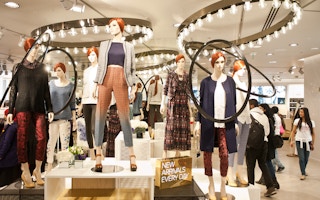Think about how many sweaters, scarves and other clothes were given as gifts this holiday season. How many times will people wear them before throwing them out?
Probably far fewer than you think. One garbage truck of clothes is burned or sent to landfills every second! The average consumer bought 60 per cent more clothes in 2014 than in 2000, but kept each garment for half as long.
Gone are the days when people would buy a shirt and wear it for years. In a world of accelerating demand for apparel, consumers want—and can increasingly afford—new clothing after wearing garments only a few times. Entire business models are built on the premise of “fast fashion,” providing clothes cheaply and quickly to consumers through shorter fashion cycles.
This linear fashion model of buying, wearing and quickly discarding clothes negatively impacts people and the planet’s resources. Here’s a look at the economic, social and environmental implications:
The economics
According to the Ellen McArthur Foundation, clothing production has approximately doubled in the last 15 years, driven by a growing middle-class population across the globe and increased per capita sales in developed economies. An expected 400 per cent increase in world GDP by 2050 will mean even greater demand for clothing.
This could be an opportunity to do better. One report found that addressing environmental and social problems created by the fashion industry would provide a $192 billion overall benefit to the global economy by 2030. The annual value of clothing discarded prematurely is more than $400 billion.
The environmental impacts
Apparel production is also resource- and emissions-intensive. Consider that:
- Making a pair of jeans produces as much greenhouse gases as driving a car more than 80 miles.
- Discarded clothing made of non-biodegradable fabrics can sit in landfills for up to 200 years.
- It takes 2,700 liters of water to make one cotton shirt, enough to meet the average person’s drinking needs for two-and-a-half years.
“
Addressing environmental and social problems created by the fashion industry would provide a $192 billion overall benefit to the global economy by 2030.
The societal impacts
Clothing production has helped spur growth in developing economies, but a closer look reveals a number of social challenges. For instance:
- According to non-profit Remake, 75 million people are making our clothes today, and 80 per cent of apparel is made by young women between the ages of 18 and 24.
- Garment workers, primarily women, in Bangladesh make about $96 per month. The government’s wage board suggested that a garment worker needs 3.5 times that amount in order to live a “decent life with basic facilities.”
- A 2018 U.S. Department of Labor report found evidence of forced and child labor in the fashion industry in Argentina, Bangladesh, Brazil, China, India, Indonesia, Philippines, Turkey, Vietnam and other countries.
Rapid consumption of apparel and the need to deliver on short fashion cycles stresses production resources, often resulting in supply chains that put profits ahead of human welfare.
So, what do we do?
So, what does a more sustainable apparel industry look like, and how do we get there? We’re starting to see some early signs of an industry in transition. Business models based on longevity, such as Rent the Runway and Gwynnie Bee, are the beginnings of an industry that supports reuse instead of rapid and irresponsible consumption. Just as Netflix reimagined traditional film rental services and Lyft disrupted transportation, we are beginning to see options for consumers to lease clothes rather than buy and stash them in their closets. Ideally, an “end of ownership” in apparel will be implemented in a way that considers impacts on jobs, communities and the environment.
This is only the beginning of the radical transformation required. Apparel companies will increasingly have to confront the elephant in the boardroom and decouple their business growth from resource use.
To meet tomorrow’s demand for clothing in innovative ways, companies will need to do what they have never done before: design, test and invest in business models that reuse clothes and maximise their useful life. For apparel companies, it’s time to disrupt or be disrupted.
Elizabeth Reichart is a research assistant and Deborah Drew is an associate for the Business Center at the World Resources Institute. This article was originally published on the WRI blog.












